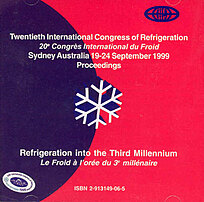
IIR document
Effects of different cooling methods on microbiological quality of large cooked beef joints.
Author(s) : MCDONALD K., SUN D. W.
Summary
Experiments were carried out after cooking using four cooling methods including forced air, slow-air, water immersion and vacuum cooling. Temperature readings were used to determine the cooling rates, and the times were quickest for vacuum cooling, air blast, slow air and water immersion, respectively. Microbiological analyses were made on samples of cooked beef immediately following cooling and thereafter at 7 to 28 days. All treatments were negative for pathogens Salmonella, Listeria monocytogens and Clostridium perfringens as well as Staphylococcus aureus, Escherichia coli, and total coliforms. Results show that the potential hazard represented by slow cooling is smaller than that represented by post-cooking contamination.
Available documents
Format PDF
Available
Public price
20 €
Member price*
Free
* Best rate depending on membership category (see the detailed benefits of individual and corporate memberships).
Details
- Original title: Effects of different cooling methods on microbiological quality of large cooked beef joints.
- Record ID : 2000-1462
- Languages: English
- Source: 20th International Congress of Refrigeration: Refrigeration into the Third Millennium.
- Publication date: 1999/09/19
Links
See other articles from the proceedings (447)
See the conference proceedings
Indexing
-
Themes:
Food engineering;
Food quality and safety. Microbiology;
Meat and meat products - Keywords: Meat; Chilling; Beef; Microbiological quality; Process; Cut; Cooking
-
Microbiological assessment of red meat for prod...
- Author(s) : STEPHAN R., THOLEN R., UNTERMANN F.
- Date : 1996
- Languages : English
- Source: Factors affecting the microbial quality of meat. 3. Cutting and further processing. Concerted Action CT94-1456.
View record
-
P-nitroaniline test: a rapid method for assessi...
- Author(s) : ORDÓÑEZ J. A., GARCÍA DE FERNANDO G. D.
- Date : 1996
- Languages : English
- Source: Factors affecting the microbial quality of meat. 4. Microbial methods for the meat industry. Concerted Action CT94-1456.
View record
-
Relationship between microbial numbers and some...
- Author(s) : DAINTY R. H., EDWARDS R. A., HIBBARD C. M.
- Date : 1996
- Languages : English
- Source: Factors affecting the microbial quality of meat. 3. Cutting and further processing. Concerted Action CT94-1456.
View record
-
The implications of modified atmosphere packagi...
- Author(s) : DOHERTY A. M.
- Date : 1996
- Languages : English
- Source: Factors affecting the microbial quality of meat. 3. Cutting and further processing. Concerted Action CT94-1456.
View record
-
The effects of chilling on beef and lamb quality.
- Author(s) : OUALI A.
- Date : 1996/10
- Languages : English
- Source: New Developments in Meat Refrigeration.
- Formats : PDF
View record
